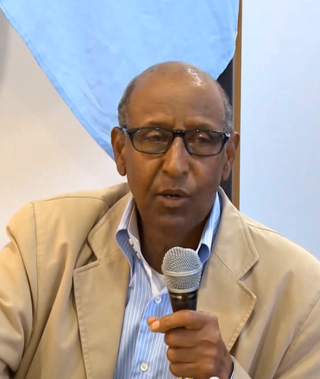Hindi cinema, popularly known as Bollywood and formerly as Bombay cinema, refers to the film industry based in Mumbai, engaged in production of motion pictures in Hindi language. The popular term Bollywood is a portmanteau of "Bombay" and "Hollywood". The industry is a part of the larger Indian cinema, which also includes South Indian cinema and other smaller film industries. The term 'Bollywood', often mistakenly used to refer to Indian cinema as a whole, only refers to Hindi-language films, with Indian cinema being an umbrella term that includes all the film industries in the country, each offering films in diverse languages and styles.
The film industry or motion picture industry comprises the technological and commercial institutions of filmmaking, i.e., film production companies, film studios, cinematography, animation, film production, screenwriting, pre-production, post-production, film festivals, distribution, and actors. Though the expense involved in making film almost immediately led film production to concentrate under the auspices of standing production companies, advances in affordable filmmaking equipment, as well as an expansion of opportunities to acquire investment capital from outside the film industry itself, have allowed independent film production to evolve.

The Somali people are a Cushitic ethnic group native to the Horn of Africa who share a common ancestry, culture and history. The East Cushitic Somali language is the shared mother tongue of ethnic Somalis, which is part of the Cushitic branch of the Afroasiatic language family. They are predominantly Sunni Muslim. Forming one of the largest ethnic groups on the continent, they cover one of the most expansive landmasses by a single ethnic group in Africa.

Cinema of Africa covers both the history and present of the making or screening of films on the African continent, and also refers to the persons involved in this form of audiovisual culture. It dates back to the early 20th century, when film reels were the primary cinematic technology in use. As there are more than 50 countries with audiovisual traditions, there is no one single 'African cinema'. Both historically and culturally, there are major regional differences between North African and sub-Saharan cinemas, and between the cinemas of different countries.

Middle Eastern cinema collectively refers to the film industries of West Asia and part of North Africa. By definition, it encompasses the film industries of Egypt, Iran, Bahrain, Iraq, Jordan, Kuwait, Lebanon, Palestine, Oman, Qatar, Saudi Arabia, Syria, United Arab Emirates, and Yemen. As such, the film industries of these countries are also part of the cinema of Asia, or in the case of Egypt, Africa.

The Egyptian film industry is today based mainly in Cairo, which is sometimes referred to as Hollywood on the Nile or Hollywood of the East, despite having its beginnings in the city of Alexandria in the early 20th century. A strong industry grew in Egypt with a high distribution rate among the Arab world, and Cairo produces around three-quarters of the Arab world's screen output. It has had a large effect on the African and Arab film industry since the early 20th century.

Tracy Fullerton is an American game designer, educator and writer, best known for Walden, a game (2017). She is a Professor in the USC Interactive Media & Games Division of the USC School of Cinematic Arts and Director of the Game Innovation Lab at USC.

Abu Talha al-Sudani also known as Tariq Abdullah, was a Sudanese member of Al Qaeda terrorist organization, an explosives expert and a close aide of Osama bin Laden.

The cinema of Somalia refers to the film industry in Somalia. The earliest forms of public film display in the country were Italian newsreels of key events during the colonial period. In 1937 the film Sentinels of Bronze was produced in Ogaden Somalia, with nearly all Somali actors. Growing out of the Somali people's rich storytelling tradition, the first few feature-length Somali films and cinematic festivals emerged in the early 1960s, immediately after independence. Following the creation of the Somali Film Agency (SFA) regulatory body in 1975, the local film scene began to expand rapidly. In the 1970s and early 1980s, popular musicals known as riwaayado were the main driving force behind the Somali movie industry. Epic and period films as well as international co-productions followed suit, facilitated by the proliferation of video technology and national television networks. In the 1990s and 2000s, a new wave of more entertainment-oriented movies emerged. Referred to as Somaliwood, this upstart, youth-based cinematic movement has energized the Somali film industry and in the process introduced innovative storylines, marketing strategies and production techniques.

Arab cinema or Arabic cinema refers to the film industry of the Arab world. Most productions come from Egyptian cinema.

Somali Americans are Americans of Somali ancestry. The first ethnic Somalis to arrive in the U.S. were sailors who came in the 1920s from British Somaliland. They were followed by students pursuing higher studies in the 1960s and 1970s, by the late 1970s through the late 1980s and early 1990s more Somalis arrived. However, it was not until the mid and late 1990s when the civil war in Somalia broke out that the majority of Somalis arrived in the United States. The Somali community in the U.S. is now among the largest in the Somali diaspora.
The Film Foundation is a US-based non-profit organization dedicated to film preservation and the exhibition of restored and classic cinema. It was founded by director Martin Scorsese and several other leading filmmakers in 1990. The foundation raises funds and awareness for film preservation projects and creates educational programs about film. The foundation and its partners have restored more than 900 films.
The Somali Film Agency (SFA) was a film regulatory body based in Mogadishu, Somalia.
The Parching Winds of Somalia (1984) is a documentary film produced by Charles Geshekter.

Abdisalam Aato is a Somali-American film director, producer, entrepreneur and media consultant. He is the founder of Olol Films, a production company at the forefront of the Somaliwood movement within the Somali film industry.

Ali Said Hassan is a Somali film producer, director, former photojournalist and archive collector.

Nollywood, a portmanteau of Nigeria and Hollywood, is a sobriquet that originally referred to the Nigerian film industry. The origin of the term goes back to the early 2000s, traced to an article in The New York Times. Due to the history of evolving meanings and contexts, there is no clear or agreed-upon definition for the term, which has made it a subject of several controversies.
Black film is a classification of film that has a broad definition relating to the film involving participation and/or representation of black people. The definition may involve the film having a black cast, a black crew, a black director, a black story, or a focus on black audiences. Academic Romi Crawford said, "I think a black film is a film work that takes into account in some way the relationship of African-Americans or blacks from the African Diaspora to filmmaking practice, means and industry. For me, it's in that relation between blacks and the film industry. How one engages in that relationship can be a mixture of black director and black acting talent; black director and black content in story; black content in story, no black director; black production money, nothing else that reads as black."

The Media History Digital Library (MHDL) is a non-profit, open access digital archive founded by David Pierce and directed by Eric Hoyt that compiles books, magazines, and other print materials related to the histories of film, broadcasting, and recorded sound and makes these materials accessible online for free. The MHDL both digitizes physical materials and acquires digital copies from outside libraries, archives, collectors, and other collaborators. Most of the material in its more than 2.5 million pages is in the public domain and therefore free for all to use with no restrictions.















